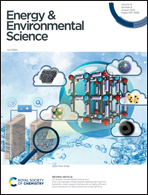A robust starch–polyacrylamide hydrogel with scavenging energy harvesting capacity for efficient solar thermoelectricity–freshwater cogeneration†
Abstract
The simultaneous production of clean water and electricity using solar energy has been proposed as a promising solution to water scarcity and electricity shortage. Here, we design a thermoelectricity–freshwater cogenerator based on a thermoelectric generator (TEG) and a starch–polyacrylamide (S-PAM) hydrogel to make the maximum use of solar energy and scavenging energy. A commercial TiNOx blue membrane with high absorptance and low emissivity covers the hot side of the TEG, which is used as the solar absorber for the main energy input. The S-PAM hydrogel underneath the cold side of TEG uses waste heat for evaporation, constituting the multistage utilization of solar energy. The temperature of the evaporation surface drops below the environmental temperature by the optimization of heat transfer channels at the cold side, resulting in a net energy gain from the environment. Simultaneously, the S-PAM hydrogel possessing a hydrophilic and porous 3D network can accommodate much water to absorb heat at the cold side of TEG during the evaporation of water, which creates a large temperature difference between the two sides of TEG and thus in turn, elevates the thermoelectricity performance. The conductive heat loss from the purifier to bulk water is fully eliminated by spraying water and the rapid heat exchange occurs at the cold side of the TEG, which results in further electricity enhancement. Due to the utilization of the scavenging energy, our hybrid cogenerator obtains an evaporation rate of 1.79 kg m−2 h−1 and a record maximum output power density of 11.39 W m−2 during water spraying for 2 minutes under one-sun illumination in reported cogeneration systems based on TEGs. Therefore, ours is a pioneering study on a highly efficient and sustainable way to harvest solar and scavenging energy.



 Please wait while we load your content...
Please wait while we load your content...